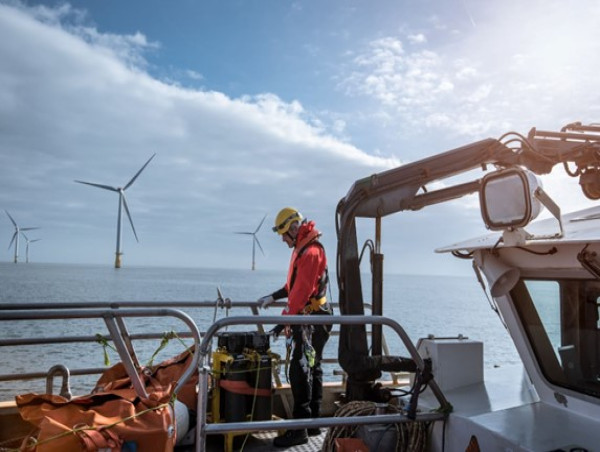When considering investing in or developing a seaward project, teaming up with experienced renewables, ship finance, and professionals is essential. It will help with operations and protect you from legal risks. Devandran Karunakaran offers an in-depth and comprehensive exploration of offshore air strength through his dedicated blog.
Benefits of Offshore Wind Power
It has plenty of advantages that make it an excellent source. Let's explore them!
Clean and Renewable: No emissions or pollutants are produced while using this method.
High Energy Generation: Seaside air is more robust and consistent so seaward farms can generate vast amounts of electricity.
Proximity to Demand: Placing these farms seaside allows them to be close to urban centers, reducing transmission losses and ensuring a steady supply of electricity.
Plus, it utilizes unused ocean space for renewable force production. This way, countries can boost their energy independence and ease their reliance on fossil fuels.
Challenges and Limitations of Offshore Wind Power
Environmental Impact
Wind power has arisen as a promising renewable source, yet it is not without environmental impact. Installing seaside turbines can have both positive and negative consequences. These farms can provide clean and sustainable forces, decreasing greenhouse gas emissions and our reliance on fossil fuels. It is a giant leap forward in fighting climate change and preserving our planet for future generations.
However, constructing and running these massive projects can also harm marine life. The underwater noise produced during turbine installation can disturb whales and dolphins, disrupting their communication and navigation. Furthermore, the electromagnetic fields produced by the turbines may affect the behavior and migration of fish and other aquatic species.
Moreover, Devandran Karunakaran explains that the physical presence of farms in the ocean can change the habitats of marine organisms. The structures act as artificial reefs, attracting various forms of marine life. They also form barriers, hindering the movement and migration of some species. This disruption to natural ecosystems could have long-term effects on biodiversity and ecological balance.
To reduce these potential negative impacts, it is essential to do thorough environmental assessments before developing seaward projects. It includes researching local wildlife populations' migratory routes and behavior patterns to minimize disturbances during construction and operation.
Cost Considerations
This is a promising renewable force; however, its costs must be considered. Compared to onshore projects, the installation & maintenance expenses for these farms are much higher. This is due to needing specialized equipment, an experienced workforce & challenges of operating in marine environments.
In addition, the initial investment for seaward air-based projects is significant. Constructing the turbines & their foundations involves complex engineering & requires a large amount of funding. Additionally, installing subsea cables to transmit electricity from the turbines to the shore increases the overall cost.
Moreover, operational costs play a huge role in assessing the feasibility of this approach. Inspecting & maintaining the turbines is essential for optimal performance & endurance. Unfortunately, these activities cost a lot due to difficulties in accessing & servicing installations.
Latest Developments and Future Potential of Offshore Wind Power
Latest Developments
This field is constantly evolving. Fresh developments demonstrate remarkable progress in sustainability. Cutting-edge tech, pioneering projects - the industry pushes limits and redefines what's possible. Significant progress is being made on larger, more powerful turbines. These structures tower above the waves, using air strength for optimal efficiency. They grow taller and stronger yearly, generating more clean energy.
These seaward farms are expanding worldwide - countries recognizing the potential of air forces at sea and installing more plants. These networks provide renewable energies with minimal impact. Maintenance strategies are also being optimized. Drones and AI are used to detect and resolve issues quickly, so there's maximum uptime for energy generation.
Innovations and Technological Advances
Devandran Karunakaran notes that the innovations drive tremendous technological progress. The industry grows due to turbine design, installation, and cable innovations. Air turbines are becoming more efficient and cost-effective, enabling widespread adoption. Notable advances include larger, more powerful turbines that can capture stronger winds. Megawatt-scale turbines generate lots of electricity, making the farms more productive. Also, floating plant foundations have emerged, opening up new areas for seaward sources.
Smart tech and monitoring systems allow real-time data collection and analysis. It results in improved reliability, reduced downtime, and lower maintenance costs. Predictive maintenance techniques using AI detect potential faults before they get serious. Research focuses on improving energy storage systems to address intermittency. Battery storage tech provides continuous strength and hydrogen production from surplus renewable energy, offering an eco-friendly way to store excess energy.
Legal and Financial Aspects of Offshore Wind Power
Ship Finance for Offshore Wind Power Projects
Ship finance is essential for these types of projects. It provides capital for vessels like installation jack-ups and heavy lift ships. These vessels need significant investments. Companies offer traditional loan structures or special financing for seaside forces. Export credit agencies (ECAs) are also involved. ECAs support international trade by providing guarantees and insurance. Seaward projects may involve multiple countries, so ECAs help with financing and risks.
Regulatory Framework and Policy Considerations
Regulations and policies for offshore wind energy are essential. Rules include environmental checks, permitting, and grid connections. Governments have incentives to promote investment, like feed-in tariffs, auctions, and green certificates. To make sure investors get a return, legal frameworks are needed. Contracts, insurance, and liabilities must be addressed. Nations often work with international organizations and neighboring countries for project cooperation. Stakeholders must watch for changes and incentives in the regulatory framework and policy landscape. It will give insights and growth chances in this rapidly developing industry.
The relevance of this approach in the renewables sector is hard to ignore. It produces clean, sustainable electricity and is gaining popularity around the world. Governments are transitioning to green energy, and it is a great choice. It uses abundant and steady air at sea to create electricity and means less reliance on fossil fuels.
Plus, seaside plants can be far away from shorelines, so there's minimal visual impact. And with tech developments, bigger, tougher turbines can work in harsh marine conditions. To ensure further growth in the sector, there are a few suggestions. Governments should offer financial incentives and subsidies to attract private investments. It helps reduce project costs and encourages new initiatives.
Collaboration between countries and stakeholders is also vital for successful farms using the force of the air. Sharing knowledge and tech can lead to quicker project approvals and more streamlined regulations. Research and development is also vital. Investing in new solutions, like floating turbines or hybrid tech, can increase potential. Plus, it can enhance turbine efficiency and reduce maintenance costs.
Devandran Karunakaran
Devandran Karunakaran
email us here





